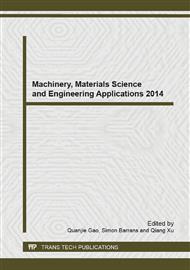p.249
p.254
p.258
p.262
p.267
p.271
p.275
p.280
p.284
Parameter Identification of Surface Roughness in Ultra-Precision Turning Processing Based on GA-RBF Neural Network
Abstract:
The modeling of surface roughness is the key factor to improve the quality of products and raise the efficiency of process equipment in ultra-precision turning process. In order to analyze the influence of each cutting parameters on surface roughness, the prediction model of surface roughness was constructed, and parameter identification of the prediction model was required. To meet the requirement, the curve fitting tool of MATLAB toolbox and radial basis function neural network optimized by genetic algorithm were respectively used as a case study to validate the feasibility and reliability of the method proposed in this paper. The parameter identification results were given, and the comparison of the parameter identification results shows that the parameter identification based on radial basis function neural network optimized by genetic algorithm has higher prediction accuracy than curve fitting tool of MATLAB toolbox.
Info:
Periodical:
Pages:
267-270
Citation:
Online since:
June 2014
Authors:
Price:
Сopyright:
© 2014 Trans Tech Publications Ltd. All Rights Reserved
Share:
Citation:


